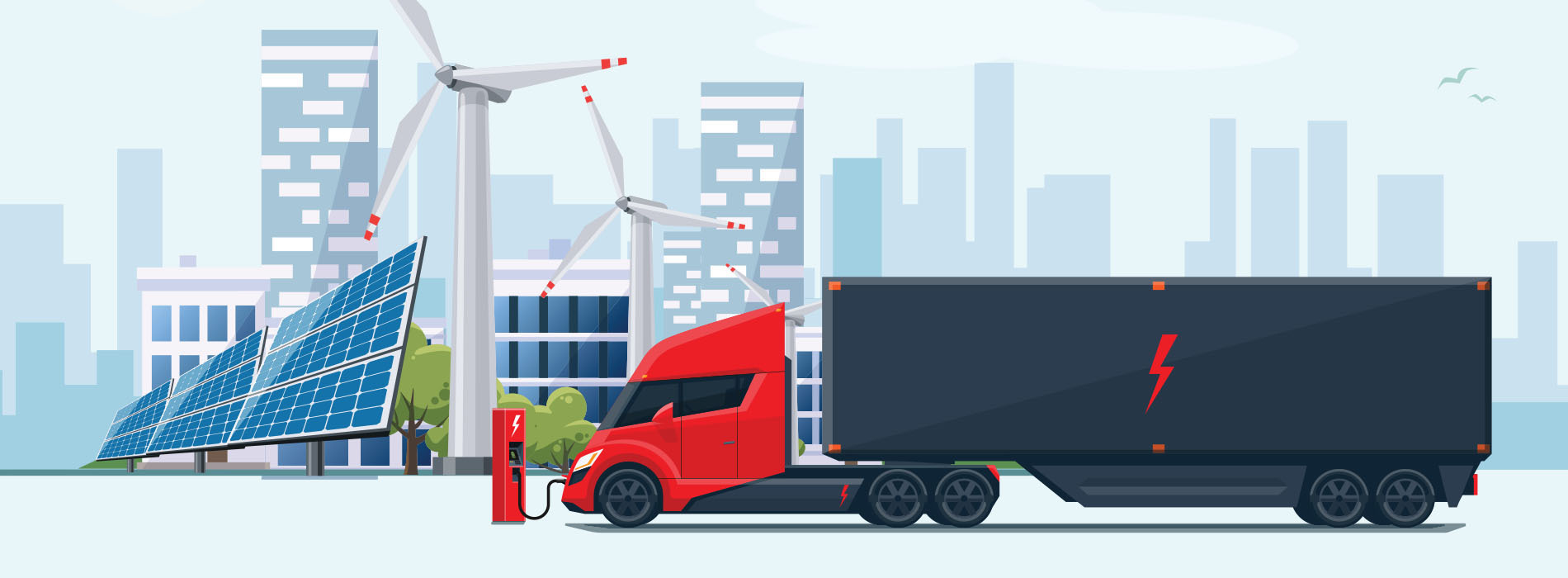Four Key Tactics to Successful Medium- and Heavy-Duty Vehicle Electrification

Medium- and heavy-duty (MD/HD) vehicles, including trucks, buses and drayage vehicles, are a relatively small share of all vehicles on U.S. roadways, yet account for about 7% of the nation’s total greenhouse gas emissions.
They are the greatest mobile source of ozone and particulate emissions, like nitrogen oxides, that pollute our air and increase respiratory illness. A recent study indicated that nitrogen dioxide concentrations are 20% higher on average in areas near warehouses. Plus, MD/HD vehicle emissions tend to disproportionately impact people in disadvantaged and low-income communities, which are often near highways, warehouses, industrial parks, ports and other freight corridors.
At the federal and state level, we’re seeing action to start to address MD/HD vehicle pollution. The Infrastructure Investment and Jobs Act authorized significant funding for bus and truck electrification, including $5 billion for low-emission and electric school buses. The Environmental Protection Agency recently adopted new standards to reduce greenhouse gas emissions from heavy-duty vehicles.
Several states have begun incentive programs for cleaner MD/HD vehicles, using cap-and-trade proceeds, utility benefits charges and Volkswagen settlement funding. California’s Advanced Clean Trucks regulation requires automakers to sell an increasing percentage of zero-emission trucks over time. Five states – Massachusetts, New Jersey, New York, Oregon and Washington – have either already adopted this regulation or committed to doing so. California also adopted the Advanced Clean Fleets regulation, which requires certain fleet operators to electrify their fleets over time.
Four key considerations
Based on the Center for Sustainable Energy’s work on state-level MD/HD vehicle policies and programs, we’ve identified four key considerations to speed the electrification of trucks and buses.
1. Replicate early wins
Some states are taking the lead on MD/HD truck electrification incentive programs with the goal of reducing air pollution exposure in historically burdened communities.
Electrifying school buses
School buses are well-suited for electrification because they travel relatively short, predictable routes and only operate a few hours a day. In recent years, the California Energy Commission (CEC) has earmarked approximately $90 million to replace old diesel buses with e-buses. For fiscal year 2024-2025 , the CEC has allocated $160 million to deploy charging infrastructure for electric school buses.
Electrifying drayage trucks
Similarly, drayage trucks, which typically transport freight to and from ports, railyards and warehouses, also travel short predictable routes. In recent years, the CEC and California Air Resources Board (CARB) have partnered to provide over $80 million to fund electric drayage trucks and on-site charging infrastructure.
Prioritizing overburdened and disadvantaged communities
To reduce air pollution in the over-burdened communities of greater Newark and Camden, the New Jersey Economic Development Authority developed a $90 million e-truck pilot, the New Jersey Zero Emission Incentive Program.
2. Build on existing EV programs
Rather than developing new programs from scratch, existing electric vehicle (EV) programs can be expanded to incorporate MD/HD vehicle incentives.
Massachusetts recently added MD/HD vehicles
The Massachusetts Offers Rebates for Electric Vehicles program, which CSE administers, recently expanded to include incentives for MD/HD vehicles. Notably, it also offers an enhanced incentive for vehicles that are registered in or spend time operating in designated environmental justice communities.
New York to expand managed charging
Some New York utilities with managed charging programs for residential customers have expanded these programs to commercial customers, enabling fleet operators to save money by charging vehicles during periods when there is excess capacity on the grid.
3. Leverage diverse funding streams to incentivize both vehicles and infrastructure
Policymakers should seek to design MD/HD vehicle incentive programs that include funding for both vehicles and infrastructure to ensure buy-in from fleet operators.
Support vehicles and infrastructure
CARB’s Hybrid and Zero-Emission Vehicle Incentive Program initially offered incentives for both MD/HD vehicles and fueling, but infrastructure incentives were removed due to limited funding from CARB’s cap-and-trade program. The CEC responded by allocating over $167 million from its share of revenue through vehicle registration fees for the EnergIIZE project, which focuses on MD/HD infrastructure.
Tap into utility funding
Additionally, policymakers should direct state agencies to work with utilities in deploying MD/HD vehicles and infrastructure, since many utilities can use ratepayer funds to develop EV infrastructure programs and vehicle-grid integration programs.
Explore other options
Numerous states have adopted or proposed clean fuels standards, which include provisions for fleet operators to receive credits for deploying charging and refueling infrastructure. For example, CARB has proposed new credit pathways that would allow owners of MD/HD infrastructure to generate revenue based on both the capacity of the charger and the amount of electricity provided.
4. Incentivize scrapping old trucks
While incentives are effective at supporting purchases of new vehicles, policymakers should also develop mechanisms to integrate these vehicles into the grid and leverage vehicle batteries to manage loads.
California's example
California utility Pacific Gas & Electric recently established pilot programs to take advantage of bidirectional chargers. The pilots offer incentives for residential customers, commercial customers and microgrid operators who use their vehicles’ batteries to power properties during outages or export electricity to the grid.
New York’s example
The New York Public Service Commission recently directed utilities to include vehicle-to-grid projects in their Value of Distributed Energy Resources (VDER) tariffs. This action will enable fleet operators to get compensated for using MD/HD batteries to store energy that gets sold back to the grid during peak times.
Now is the time for action
The last few years have seen tremendous progress in electrifying the light-duty transportation sector, with more EVs entering the market and new federal funding for EV charging. The next step is for policymakers to dedicate funds and develop incentive programs to support MD/HD electrification and integration with the grid, which will reduce greenhouse gas emissions, enhance grid management and benefit those communities most impacted by air pollution.


